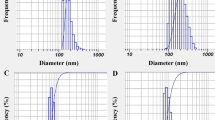Abstract
Considering the cases of fungal resistance to classic antifungals, it is necessary to develop more efficient and innovative therapies capable of reversing this situation. Fluconazole is an antifungal frequently used in the treatment of mycosis and some fungi developed resistance to its mechanism of action. In this work, fluconazole and green propolis were co-encapsulated in chitosan nanoparticles to be explored in order to promote a synergistic effect to enhance its therapeutic efficacy. However, because of the complexity of the chemical composition of green propolis, it was necessary to develop a simple and precise methodology to quantify fluconazole in the formulation. High Efficiency Liquid Chromatography methodology was developed and validated following the Brazilian regulatory guidelines (ANVISA, RDC 166/2017) for the separation of co-eluted peaks of fluconazole and green propolis in the nanoparticle supernatant. Applying the method developed, it was possible to quantify fluconazole in the same sample containing propolis. Thus, the results allow to affirm that it is a specific test, effective, precise and robust, which helped to determine the efficiency of association of the compounds within the nanoparticle. The method can be applied to quantify compounds that have similar chromatographic retention times.





Similar content being viewed by others
References
Souza ACO, Amaral AC (2017) Antifungal therapy for systemic mycosis and the nanobiotechnology era: improving efficacy, biodistribution and toxicity. Front Microbiol 8:336. https://doi.org/10.3389/fmicb.2017.00336
Grant SM, Clissold SP (1990) Fluconazole a review of its pharmacodynamic and pharmacokinetic properties, and therapeutic potential in superficial and systemic mycoses. Drugs 39:877–916. https://doi.org/10.2165/00003495-199039060-00006
Costa AD, Araujo DE, Cabral MS, Brito IT, Leite LBM, Pereira M, Amaral AC (2019) Development, characterization, and in vitro-in vivo evaluation of polymeric nanoparticles containing miconazole and farnesol for treatment of vulvovaginal candidiasis. Med Mycol 57:52–62. https://doi.org/10.1093/mmy/myx155
Kalia VC, Patel SKS, Kang YC, Lee JK (2019) Quorum sensing inhibitors as antipathogens: biotechnological applications. Biotechnol Adv 37:68–90. https://doi.org/10.1016/j.biotechadv.2018.11.006
Tobaldini-Valerio FK, Bonfim-Mendonça PS, Rosseto HC, Bruschi ML, Henriques M, Negri M, Silva S, Svidzinski TI (2016) Propolis: a potential natural product to fight Candida species infections. Future Microbiol 11:1035–1046. https://doi.org/10.2217/fmb-2015-0016
Patel SKS, Kim JH, Kalia VC, Lee JK (2019) Antimicrobial activity of amino-derivatized cationic polysaccharides. Indian J Microbiol 59:96–99. https://doi.org/10.1007/s12088-018-0764-7
Chandra HK, Prabha S, Chandra R, Ahmed B, Nimesh S (2016) Advances in preparation and characterization of chitosan nanoparticles for therapeutics. Artif Cells Nanomed Biotechnol 44:305–314. https://doi.org/10.3109/21691401.2014.948548
Moazeni M, Hamid RK, Majid S, Morteza-Semnani K, Nabili M, Gohar AA, Akbari J, Lotfali E, Nokhodchi A (2016) Time to overcome fluconazole resistant Candida isolates: solid lipid nanoparticles as a novel antifungal drug delivery system. Colloids Surf B Biointerfaces 142:400–407. https://doi.org/10.1016/j.colsurfb.2016.03.013
Bianchin MD, Borowicz SM, Machado GRM, Pippi B, Guterres SS, Pohlmann AR, Fuentefria AM, Kulkamp-Guerreiro IC (2019) Lipid core nanoparticles as a broad strategy to reverse fluconazole resistance in multiple Candida species. Colloids Surf B Biointerfaces 175:523–529. https://doi.org/10.1016/j.colsurfb.2018.12.011
Calvo P, Remunan-Lopez C, Vila-Jato JL, Alonso MJ (1997) Novel hydrophilic chitosan-polyethylene oxide nanoparticles as protein carriers. J Appl Polym Sci 63:125–132
ANVISA (2017) RDC 166 Guidelines. http://antigo.anvisa.gov.br/documents/10181/2721567/RDC_166_2017.
ElBaradei A (2020) A decade after the emergence of Candida auris: what do we know? Eur J Clin Microbiol Infect Dis 39(9):1617–1627. https://doi.org/10.1007/s10096-020-03886-9
Tang SS, Apisarnthanarak A, Hsu LY (2014) Mechanisms of β-lactam antimicrobial resistance and epidemiology of major community- and healthcare- associated multidrug-resistant bacteria. Adv Drug Deliv Rev. https://doi.org/10.1016/j.addr.2014.08.003
Garg D, Muthu V, Sehgal IS, Ramachandran R, Kaur H, Bhalla A, Puri GD, Chakrabarti A, Agarwal R (2021) Mucormycosis (CAM): case report and systematic review of literature. Mycopathologia 186:289–298. https://doi.org/10.1007/s11046-021-00528.2
Popova M, Bankova V, Butovska D, Petrov V, Nikolova-Damyanova B, Sabatini AG, Marcazzan GL, Bogdanov S (2004) Validated methods for the quantification of biologically active constituents of poplar-type propolis. Phytochem Anal 15:235–240. https://doi.org/10.1002/pca.777
Popova M, Chen CN, Chen PY, Huang CY, Bankova V (2010) A validated spectrofotometric method for quantification of prenylated flavanones in pacific propolis from Taiwan. Phytochem Anal 21:186–191. https://doi.org/10.1002/pca.1176
Ayub AC, Vianna-Soares CD, Ferreira LAM (2007) Fluconazol method validation by RP-HPLC for determ ination in biological skin matrices. J Chromatogr Sci 45:286–290
Aloudah NM, Radwan MA, Omar NFA, Jacobs S (2005) HPLC assay of fluconazole and its application to patients with early septic shock. J Liq Chromatogr RT 28:571–580. https://doi.org/10.1081/JLC-200047213
Acknowledgements
The authors thank the Coordination for the Improvement of Higher Education Personnel (CAPES) for Silva JT scholarship and Federal University of Goiás for providing infrastructural facilities.
Author information
Authors and Affiliations
Corresponding author
Ethics declarations
Conflict of interest
The authors declare there are no conflict of interest.
Additional information
Publisher's Note
Springer Nature remains neutral with regard to jurisdictional claims in published maps and institutional affiliations.
Supplementary Information
Below is the link to the electronic supplementary material.
Rights and permissions
About this article
Cite this article
da Silva, J.T., de Oliveira, M.G., de Paula, J.R. et al. HPLC Method Validated for Quantification of Fluconazole Co-Encapsulated with Propolis Within Chitosan Nanoparticles. Indian J Microbiol 61, 364–369 (2021). https://doi.org/10.1007/s12088-021-00954-2
Received:
Accepted:
Published:
Issue Date:
DOI: https://doi.org/10.1007/s12088-021-00954-2




